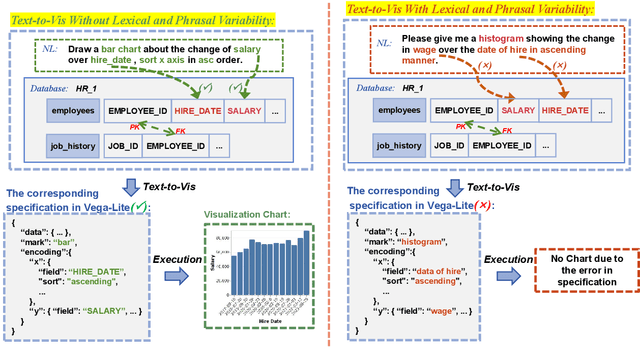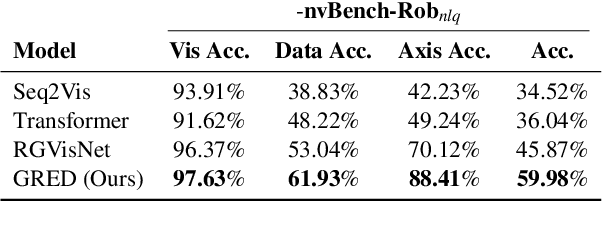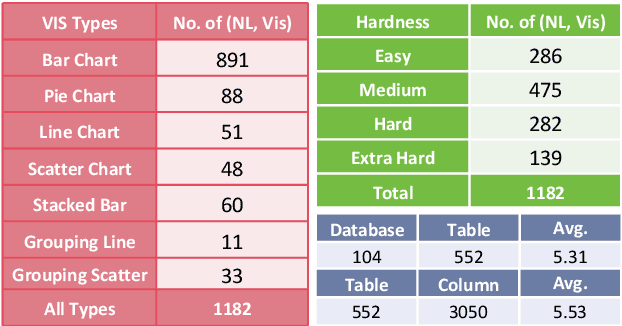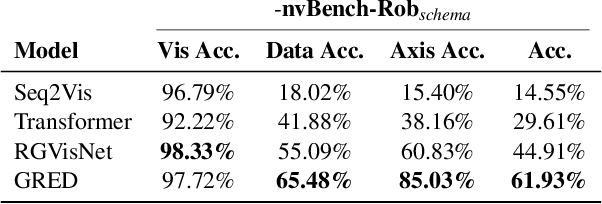Jinwei Lu
Towards Robustness of Text-to-Visualization Translation against Lexical and Phrasal Variability
Apr 11, 2024



Abstract:Text-to-Vis is an emerging task in the natural language processing (NLP) area that aims to automatically generate data visualizations from natural language questions (NLQs). Despite their progress, existing text-to-vis models often heavily rely on lexical matching between words in the questions and tokens in data schemas. This overreliance on lexical matching may lead to a diminished level of model robustness against input variations. In this study, we thoroughly examine the robustness of current text-to-vis models, an area that has not previously been explored. In particular, we construct the first robustness dataset nvBench-Rob, which contains diverse lexical and phrasal variations based on the original text-to-vis benchmark nvBench. Then, we found that the performance of existing text-to-vis models on this new dataset dramatically drops, implying that these methods exhibit inadequate robustness overall. Finally, we propose a novel framework based on Retrieval-Augmented Generation (RAG) technique, named GRED, specifically designed to address input perturbations in these two variants. The framework consists of three parts: NLQ-Retrieval Generator, Visualization Query-Retrieval Retuner and Annotation-based Debugger, which are used to tackle the challenges posed by natural language variants, programming style differences and data schema variants, respectively. Extensive experimental evaluations show that, compared to the state-of-the-art model RGVisNet in the Text-to-Vis field, GRED performs better in terms of model robustness, with a 32% increase in accuracy on the proposed nvBench-Rob dataset.
Application of Neural Network Algorithm in Propylene Distillation
Apr 05, 2021
Abstract:Artificial neural network modeling does not need to consider the mechanism. It can map the implicit relationship between input and output and predict the performance of the system well. At the same time, it has the advantages of self-learning ability and high fault tolerance. The gas-liquid two phases in the rectification tower conduct interphase heat and mass transfer through countercurrent contact. The functional relationship between the product concentration at the top and bottom of the tower and the process parameters is extremely complex. The functional relationship can be accurately controlled by artificial neural network algorithms. The key components of the propylene distillation tower are the propane concentration at the top of the tower and the propylene concentration at the bottom of the tower. Accurate measurement of them plays a key role in increasing propylene yield in ethylene production enterprises. This article mainly introduces the neural network model and its application in the propylene distillation tower.
Neural network algorithm and its application in temperature control of distillation tower
Jan 03, 2021



Abstract:Distillation process is a complex process of conduction, mass transfer and heat conduction, which is mainly manifested as follows: The mechanism is complex and changeable with uncertainty; the process is multivariate and strong coupling; the system is nonlinear, hysteresis and time-varying. Neural networks can perform effective learning based on corresponding samples, do not rely on fixed mechanisms, have the ability to approximate arbitrary nonlinear mappings, and can be used to establish system input and output models. The temperature system of the rectification tower has a complicated structure and high accuracy requirements. The neural network is used to control the temperature of the system, which satisfies the requirements of the production process. This article briefly describes the basic concepts and research progress of neural network and distillation tower temperature control, and systematically summarizes the application of neural network in distillation tower control, aiming to provide reference for the development of related industries.
 Add to Chrome
Add to Chrome Add to Firefox
Add to Firefox Add to Edge
Add to Edge